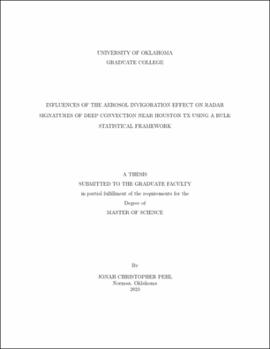| dc.description.abstract | Aerosol-deep convective cloud (DCC) interactions remain a frontier in the study of water cycles, energy budgets, climate models, and air quality, partly because it can be difficult to disentangle aerosol impacts from the impacts of variations in the temperature, moisture, and wind fields that strongly affect the structure and evolution of DCCs. Theoretical and observational studies have shown that increased aerosol concentration ingestion by DCC updrafts can promote their invigoration by delaying the warm rain process and increasing latent heat release at the freezing level through a narrowing of the drop size distribution. This mechanism, known as the aerosol invigoration effect (AIE), increases a convective precipitating updraft’s strength and alters microphysical structures throughout its lifetime. However, other recent studies refute claims that the AIE increases updraft strength and instead claim that increased aerosol loading can weaken updrafts and/or reduce precipitation intensity. This study seeks to examine the impact of the AIE on DCCs by using a bulk statistical framework with a sample size of 2500 DCCs observed by ground-based radar observed in the vicinity of Houston, TX in the months of June, July, and August between 2013 – 2021. The vicinity of Houston was chosen for this investigation as regular summertime sea-breeze triggered DCCs occur in low-shear environments and weak synoptic-forcing conditions, with large aerosol concentration differences on varying days. Data are obtained from the Houston-Galveston WSR-88D (KHGX), ECMWF Reanalysis v5 (ERA5), Modern-Era Retrospective analysis for Research and Applications, version 2 (MERRA-2), and Texas Commission for Environmental Quality (TCEQ). DCC tracking was completed using the Multi-Cell Identification and Tracking (MCIT) algorithm using radar data from KHGX. Results from a spatial analysis of DCC locations using 2D kernel density estimates show that their locations, initiation times, and aerosol regime are largely governed by the direction and strength of the sea-breeze. Composite difference contoured frequency by altitude diagrams (CFADs) are used to uncover differences in the vertical structure of dual-polarization radar signatures and show that under certain meteorological conditions, differences in radar data consistent with the AIE are present across many DCCs within specific meteorological regimes. These regimes have been shown to promote the AIE by previous work, such as environments with moderate to high instability, low shear, and high free tropospheric relative humidity. Additionally, some meteorological regimes promote inhibition of updraft and precipitation intensity for DCCs under high aerosol mass loading, mainly within an anthropogenic aerosol regime. | en_US |
